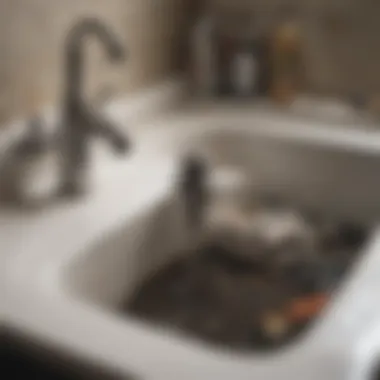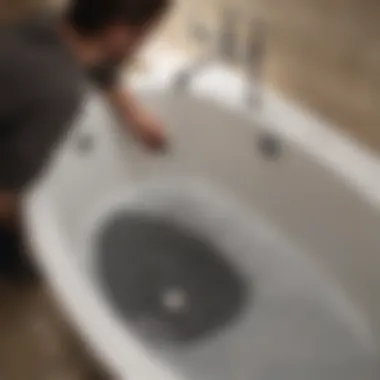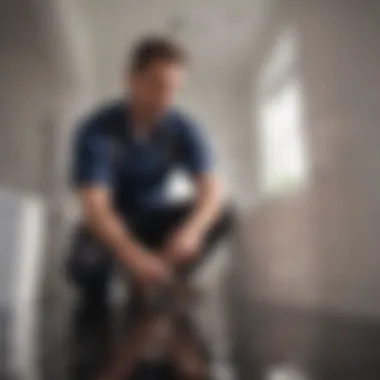Effective Strategies for Unclogging a Tub Drain


Intro
Maintaining a functional plumbing system in your home is crucial for comfort and convenience. One common issue many homeowners face is a clogged tub drain. Understanding the mechanisms behind clogs can lead to effective solutions, saving time and money.
When water drains slowly or not at all, it can be frustrating. Often, clogs result from a buildup of hair, soap residue, or other debris. While some clogs can be addressed with simple DIY methods, others may require professional attention.
Key Insights and Trends
Common Causes of Clogs
Recognizing what leads to clogs is essential for prevention and quick resolution. Some prevalent causes include:
- Hair: This is the leading cause of clogs. Hair can accumulate over time, creating an obstruction in the drain.
- Soap Scum: Residual soap can build up, combining with hair and debris to form a stubborn clog.
- Foreign Objects: Items such as toys or cotton swabs can accidentally fall into the drain.
- Grease and Oil: These substances can congeal and create blockages, often seen in kitchen sinks but possible in tub drains too.
Trends in Drain Maintenance
Recent trends focus on proactive maintenance. Many homeowners now favor natural solutions over chemical drain cleaners due to concerns about environmental impact and pipe health. Consider using hot water and vinegar as a preventative measure against clogs.
Practical Tips and How-To Guides
Step-by-Step Unclogging Techniques
If you find yourself facing a clogged tub drain, here are effective methods you can try:
- Manual Removal:
- Hot Water:
- Baking Soda and Vinegar:
- Use Commercial Drain Cleaners:
- Check the P-Trap:
- Use a drain snake or plumber's auger to reach and remove hair and debris.
- If available, employ a wet/dry vacuum to suck out loose materials.
- Boil water and pour it down the drain. This can help dissolve grease and soap build-up.
- Pour 1/2 cup of baking soda followed by 1/2 cup of vinegar into the drain. Allow the mixture to fizz for about 15 minutes, then flush with hot water.
- If the clog persists, you may consider using a drain cleaner such as Drano or Liquid Plumber. Follow the instructions carefully to avoid damaging your pipes.
- Remove the trap under the sink to clean out any blockage directly. Ensure to have a bucket to catch water.
When to Call a Professional
If your attempts fail, it may signal a more significant plumbing issue. Consider seeking professional assistance if:
- The water backs up into other fixtures in your home.
- You notice persistent slow drainage even after attempted fixes.
- There are visible leaks or signs of damage to pipes.
“Ignoring a clogged drain can lead to more serious plumbing issues, including water damage.”
Understanding how to effectively address a clogged tub drain not only helps resolve immediate issues but also contributes to overall home maintenance. Through preventative measures and proper handling of clogs, you can ensure a smoothly functioning plumbing system.
Preface to Drain Clogs


Understanding drain clogs is fundamental for anyone dealing with plumbing issues. In homes, clogged drains can lead to significant inconveniences and, at times, costly repairs if not addressed promptly.
When a tub drain becomes clogged, it affects the overall functionality of the bathroom. Ignoring it can lead to more severe plumbing problems down the line. Thus, having a grasp on why clogs occur and how to deal with them is crucial.
Understanding Drain Blockages
Drain blockages happen due to various reasons, some more common than others. Primarily, it’s about the accumulation of debris over time. An effective strategy involves knowing what obstructs water flow and addresses it.
Fats, oils, dirt, and hair are common contributors to blockages. Once these materials accumulate, they restrict the passage of water, causing it to drain slowly or not at all. Understanding the nature of these blockages can lead to better prevention and maintenance strategies.
Common Causes of Tub Drain Clogs
Tub drains often face specific challenges that lead to clogs. Recognizing these causes can help in prevention and effective treatment.
- Hair: One of the most notorious culprits. When people wash their hair, strands fall and gather in the drain, forming a dense mass over time.
- Soap Residue: Soap can build up and combine with hair and other materials, further promoting blockage.
- Foreign Objects: Items such as toys, jewelry, or personal care products can accidentally slip into the tub drain, leading to immediate blockage.
- Mineral Buildup: In areas with hard water, minerals can accumulate inside pipes, creating restrictions that hinder drainage.
Awareness of these common causes equips homeowners with the tools they need to maintain their drains effectively and prevent serious plumbing problems.
Signs of a Clogged Tub Drain
Recognizing the signs of a clogged tub drain is crucial for effective maintenance and prevention. Ignoring these signals can lead to more significant issues, including extensive plumbing repairs and unpleasant household odors. Homeowners, renters, and those who take pride in their living spaces must be aware of what to look for to address potential problems early. This section dives into the common indicators of a clogged tub drain, helping you make informed decisions about maintenance and repair.
Slow Drainage Issues
One of the primary signs of a clogged tub drain is slow drainage. When water fails to flow down the tub, it may seem minor at first. However, it can indicate that debris, hair, or soap residue is building up within the pipes. As the clog grows, the issues become more pronounced.
A slow drain does more than inconvenience daily routines. If not addressed, it can lead to stagnant water, which promotes bacteria growth and can affect indoor air quality. Homeowners should monitor the flow of water regularly. If you notice it lingering longer than usual, it is best to act quickly. Consider using common household tools like a plunger or a drain snake to dislodge the blockage at this stage.
Unpleasant Odors
Another clear sign of a clogged tub drain is the presence of unpleasant odors. These odors often arise due to decomposing organic matter trapped in the pipes. Hair, soap, and other bathroom products can generate foul smells if they are not washed away effectively.
Ignoring these odors could result in health risks, as bacteria thrive in damp environments. It is wise to investigate sources of the smells. Regular cleaning of the drain introduces hygiene and minimizes these odors. If the smell persists even after cleaning, a more comprehensive approach to unclogging may be necessary.
Water Pooling
Water pooling in the tub is often the most evident sign of a clog. This situation occurs when the water cannot drain effectively due to a significant blockage. Pooling water not only hampers functionality but can also lead to slippery surfaces, creating safety hazards.
Pooling indicates the necessity for immediate action. Failing to address significant clogs can lead to more severe plumbing problems over time. Standing water may overflow into other parts of the bathroom, leading to potential water damage and costly repairs.
Addressing these signs swiftly can save on extensive repairs and help maintain a pleasant living environment.
Once these signs are identified, homeowners should assess their tools and methods for removing the blockage. The quicker the action taken, the more manageable the problem will be.
Initial Assessment and Preparation
Before diving into any methods for unclogging a tub drain, it’s essential to conduct a thorough initial assessment and preparation. This stage is crucial for successfully addressing the blockage without causing further damage or complications. Inadequate preparation can result in wasted time, potential injury, or even more severe plumbing issues.
The first step is to understand the situation. Identifying the signs of a clog, such as slow drainage or unpleasant odors, allows for a more focused approach. Additionally, different blockages may require specific tools or techniques. This insight helps in gathering the right materials before starting the cleanup process.


Gathering Necessary Tools
Having the correct tools at hand can significantly improve efficiency and effectiveness. Essential tools for unclogging a tub drain may include:
- Plunger: A standard tool for many types of clogs. Ensure it’s clean and suitable for tub drains.
- Drain snake: A flexible tool designed to reach deep blockages.
- Bucket: Useful for collecting excess water and debris during the cleaning process.
- Gloves: Protect your hands from chemicals and dirt.
- Flashlight: Useful for inspecting the drain and seeing obstacles clearly.
- Chemical drain cleaners: Use with caution, as they can be harmful.
Having these tools ready creates a strong foundation for tackling the blockage effectively and safely.
Safety Considerations
Safety should always be a priority when addressing plumbing issues. A few essential safety measures to consider include:
- Wear protective gear: Gloves and safety goggles can prevent injuries or irritations.
- Ventilation: If using chemical drain cleaners, ensure the area is well ventilated to avoid inhaling harmful fumes.
- Read labels: If using commercial products, it is vital to read the labels to understand how to handle them correctly and prevent accidents.
- Avoid mixing products: Mixing different types of chemicals can create toxic reactions.
Being aware of these safety precautions not only safeguards your health but also enhances the efficiency of the cleaning process.
Proper preparation and attention to safety can avert many common issues associated with clogged drains.
DIY Methods for Unclogging Tub Drains
DIY methods for unclogging tub drains are invaluable within this article. They provide homeowners with practical solutions to tackle common issues without needing to spend on professional services. These methods are often quick and can be done using commonly found household items or tools. Understanding these techniques can save time and frustration, especially in emergencies.
Using a Plunger
Using a plunger is a foundational technique for unclogging drains. This tool creates pressure that can dislodge blockages. When using a plunger, it is important to create a proper seal over the drain. Ensure there is enough water in the tub to cover the plunger's cup. Then, apply firm, even pressure, pushing down and pulling up repeatedly. A few minutes of this should give enough force to potentially clear the clog.
Employing a Drain Snake
A drain snake, also known as a plumbing auger, is another effective method for clearing clogs. This tool is flexible and can navigate the curves of a drain pipe. To use a drain snake, insert the end into the drain and turn the handle to extend the snake further into the pipe. When you feel resistance, this indicates you’ve reached the blockage. Rotate the snake to dislodge or grab the obstruction. Pull back gradually, bringing any debris with it.
Chemical Drain Cleaners
Chemical drain cleaners are powerful products designed to dissolve clogs using corrosive substances. Recommendations for using such cleaners include:
- Opt for products that specify compatibility with your plumbing system. Products like Liquid-Plumr or Drano are often recommended.
- Always follow the manufacturer's instructions for application, including safety guidelines.
Chemical cleaners can be a beneficial option because they often provide fast results. However, their effectiveness might vary depending on the type of clog. They may not work well with severe blockages that require physical removal.
Precautions
When using chemical drain cleaners, several precautions are essential:
- Wear protective gloves and goggles to prevent exposure to harmful chemicals.
- Ensure good ventilation in the area to avoid inhaling fumes.
- Never mix different brands or types of chemicals, as this can create dangerous reactions.
These precautions highlight the importance of safety when using chemical cleaners. They can provide an effective solution, but the potential risks must not be overlooked.
Baking Soda and Vinegar Method
The baking soda and vinegar method is a popular, eco-friendly approach for unclogging tub drains. It relies on a simple chemical reaction between the two substances. Begin by pouring about half a cup of baking soda down the drain, followed by half a cup of vinegar. This combination creates a fizzing action that can help to dislodge minor clogs. After allowing it to sit for about 30 minutes, flush the drain with hot water to clear out any remaining debris. This method is safe for most plumbing and is cost-effective.


When to Call a Professional
Clogged drains can be a significant inconvenience for homeowners and renters alike. While many clogs can be resolved through DIY methods, understanding when to seek professional help is crucial. It can prevent potential damage and ensure the problem is resolved effectively. Recognizing the right time to call a plumber can save you money and time in the long run.
Identifying Severe Clogs
Some clogs are more than just a simple blockage. Severe clogs could indicate larger issues within your plumbing system. If you notice that your tub drain is completely blocked and water is not draining at all, this is a strong sign to call a professional.
Signs of a severe clog include:
- Multiple drains backing up: If your tub drain, sink, and toilet are all having issues, it could be a sign of a serious blockage in your sewage line.
- Repeated clogs: If you find yourself frequently unclogging the drain, this may indicate deeper problems.
- Unusual noises: Gurgling sounds in the pipes may point to significant obstructions.
- Smells: Bad odors that persist indicate stagnant water and decaying materials that need professional intervention.
In these scenarios, a qualified plumber can perform a thorough assessment and identify the root cause.
Understanding Plumbing Issues
Sometimes, the problem is not just a clogged drain. It can stem from plumbing issues that require the expertise of a professional. If you have experienced:
- Old or damaged pipes: Aging pipes can develop cracks or become corroded, which may lead to persistent clogs.
- Improper installation: If plumbing was installed incorrectly, this can lead to repeated blockages.
- Tree roots: Roots can infiltrate underground pipes, causing severe obstructions.
These situations demand professional attention. Attempting to fix deeper plumbing issues without experience can lead to further damage or expensive repairs. The cost of a professional may seem steep initially but it can prevent larger liabilities later on.
"Plumbing issues require a skilled hand. Ignoring them only amplifies the problem over time."
Preventative Measures for Future Clogs
Preventative measures are essential in maintaining a clear tub drain. By addressing potential issues before they escalate, homeowners can save time, effort, and money. Ensuring that the drains remain clog-free has benefits beyond convenience; it promotes a healthier environment and preserves the plumbing infrastructure.
Regular Maintenance
Implementing regular maintenance routines can significantly reduce the incidence of tub drain clogs. This involves routine check-ups and cleanings to identify and resolve issues. A good practice is to clean the drain every month. This can be done by pouring boiling water down the drain to dissolve any build-up. Additionally, using a mixture of vinegar and baking soda can help break down grease and soap residue.
Using Drain Screens
Using drain screens can be an effective barrier against hair and larger debris that often contribute to clogs. They act as physical filters, catching these materials before they enter the pipes. Installing a drain screen is simple and requires minimal tools. They come in various sizes to fit different tub designs. Make sure to clean these screens regularly to prevent them from becoming overloaded. Regularly cleaning ensures optimal performance, thus reducing the chances of future blockages.
Monitoring Hair and Soap Residue
Monitoring hair and soap residue is crucial in preventing clogs. Hair tends to collect in the drain and is often a primary culprit for blockages. After each bath or shower, try to remove visible hair from the drain. You can also train family members or guests to do the same.
Moreover, certain soaps can create residue over time. Using biodegradable soaps can minimize this issue. Regularly inspecting the drain for soap scum and cleaning it will also go a long way in keeping the drains clear.
By adopting these preventative measures, you not only enhance the functionality of your plumbing system but also ensure a more pleasant bathing experience. Taking small steps can lead to significant improvements over time.
Summary and The End
In summary, understanding the strategies for unclogging a tub drain is vital for homeowners. One should take proactive measures to avoid the hassle and potential costs resulting from clogged drains. This article encompasses the most common causes of clogs, effective DIY methods for unclogging, and the signs indicating the need for professional assistance.
Key Takeaways
- Knowledge is Power: Recognizing the signs of a clog early can help to mitigate severe plumbing issues.
- DIY Techniques: Methods such as using a plunger, drain snake, or natural products like baking soda and vinegar can often resolve minor clogs effectively.
- Importance of Maintenance: Regular cleaning and preventive measures play a significant role. For instance, using drain screens can trap debris, preventing buildup over time.
- When to Seek Help: Understanding when a clog is beyond DIY repair is crucial to avoiding further plumbing problems.
Final Thoughts on Drain Maintenance
Maintaining a drain system is not merely about resolution but prevention. Regularly schedule maintenance checks to identify potential issues before they escalate. Consider adopting a cleaning routine, which can involve flushing the drain with hot water or vinegar occasionally. Moreover, educate all household members about proper disposal of materials to avoid unnecessary clogs. By making these practices a norm, the longevity of your tub drain can be considerably enhanced, and you can enjoy a seamless bathing experience.



